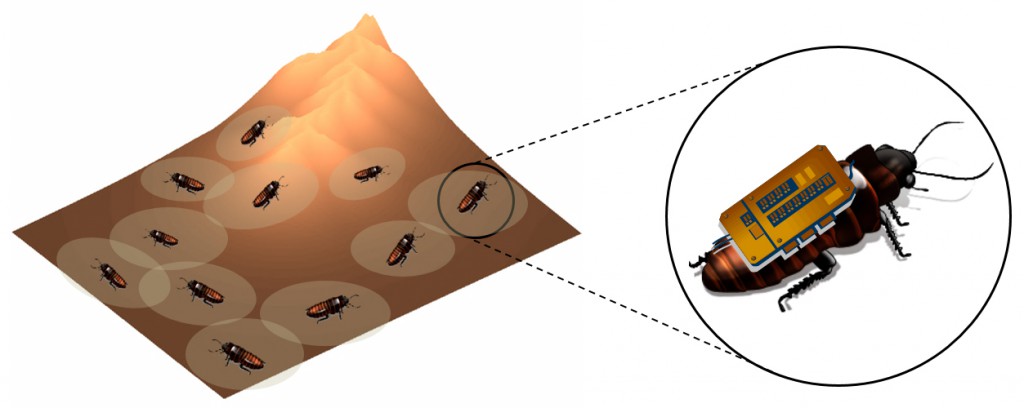Whether it’s assessing a wrecked building, exploring uncharted territories, or conducting surveillance in a hostile environment — the modern cockroach can do it all. A research team from North Carolina State University has devised a software that uses a swarm of “cyborg cockroaches” or “biobots” (roaches fitted with electronic sensors) to map dangerous or uncertain areas, such as a collapsed building, reports ExtremeTech.

Cyborg roaches carrying a “backpack” will be especially useful in places where GPS technology can’t be employed or where emergency responders cannot reach. From NC University.
Why cockroaches? Roaches posses a self-powered locomotion system and a biological autonomy that helps them survive. Roaches “will run away when they sense danger, which makes them hard to trap or squash. That’s really useful in uncertain, dynamic environments,” said Dr. Alper Bozkurt, from the Department of Electrical and Computer Engineering, who led the project in 2012.
Cockroaches, while they do not have highly organized group behaviors, possess some cooperation and information-sharing capabilities. And, as it turns out, their unpredictability could actually be an advantage. “One characteristic of biobots is that their movement can be somewhat random. We’re exploiting that random movement to work in our favor,” said Dr. Edgar Lobaton, assistant professor of Electrical and Computer Engineering at NC State.
Perhaps more astonishing than all this is the fact that this line of work is nothing new for the school. NC State’s Greg Gage and Tim Marzullo, founders of Backyard Brains, created RoboRoach, “the world’s first commercially available cyborg.”
How do the cyborg roaches work?
The robotic insects are released to cover maximum area. Operators can then send a signal to cockroaches to keep moving until they hit an obstruction, like a wall, and then track along that obstruction. This phenomenon is called “wall following”. Commands are relayed via electrodes connected to the insects’ antennae and location information is obtained via sensors that signal operators through radio waves whenever biobots get close to one other. A software then translates the signals to create a rough map of the interior environment.
The scope of biobots
Researchers claim that cockroaches are not harmed during the surgery that makes them biobots. From fennfoot.
Advanced technology could enable trapped individuals to press a button on the biobot to signal their presence and ask for help. Roaches could even be outfitted with appropriate audio sensors which would pick up sound from victims and send signals. Since roaches also have a higher tolerance for radiation, they could be equipped with chemical and radiation detectors.
Will creating robotic insects send the wrong signal to amateurs?
While speaking to NBC News, Lobaton said that it’s important to recognize that the cockroaches “have their own behavior, their own programming from nature.” Roaches, especially the Madagascar hissing cockroach, are big enough to be laden with a sizable electronics pack on their backs. The backpack can be removed when not in use and the cockroach can be set free. It’s a fairly blunt form of control, but it’s cheap, reliable, and easy to install.
Backyard Brains, which created the world’s first commercially available cyborg roach, will start selling their Roboroaches for $99 this November. But not everyone is singing the praises of this DIY neuroscience marvel. Ethical questions concerning the message creators are sending through this project are rife. Critics like Michael Allen Fox, professor of philosophy at Queen’s University in Kingston, Canada has doubts, “They encourage amateurs to operate invasively on living organisms” and “encourage thinking of complex living organisms as mere machines or tools.”